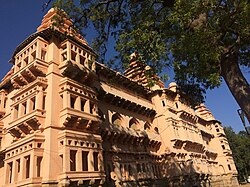| Chandragiri Fort, Tirupati | |
|---|---|
| Tirupati | |
 Raja Mahal of Chandragiri Fort | |
| Site information | |
| Type | Fort |
| Controlled by | Government of Andhra Pradesh |
| Condition | Ruins |
| Location | |
| Coordinates | 13°34′57″N79°18′20″E / 13.58250°N 79.30556°E |
| Site history | |
| Built | 11th century |
| Materials | Granite Stones and lime mortar |

Chandragiri Fort is an historical fort located in the Chandragiri suburb of Tirupati, in Tirupati district of Andhra Pradesh, India. The fort, with its rectangular bastions and steep moat, was built during the reign of Immadi Narasimha Yadavaraya (1000 AD), who ruled from Narayanavanam. It is mostly associated with the Vijayanagara Emperors. Kapilendra Deva captured it in 1460 CE.


